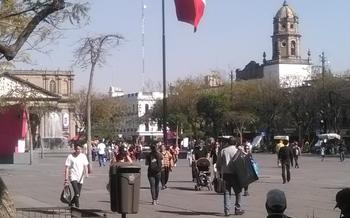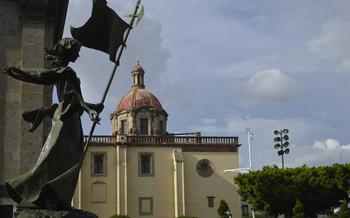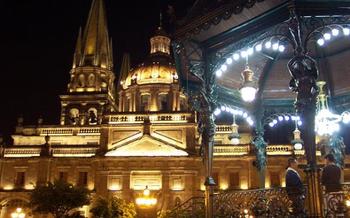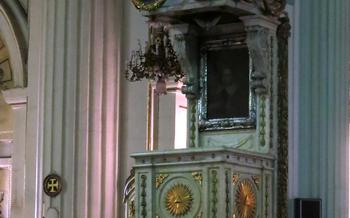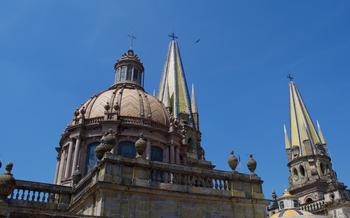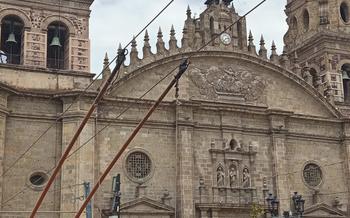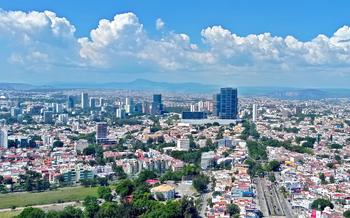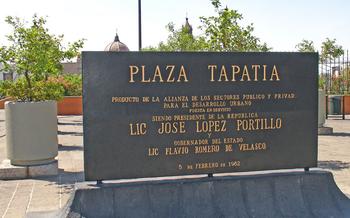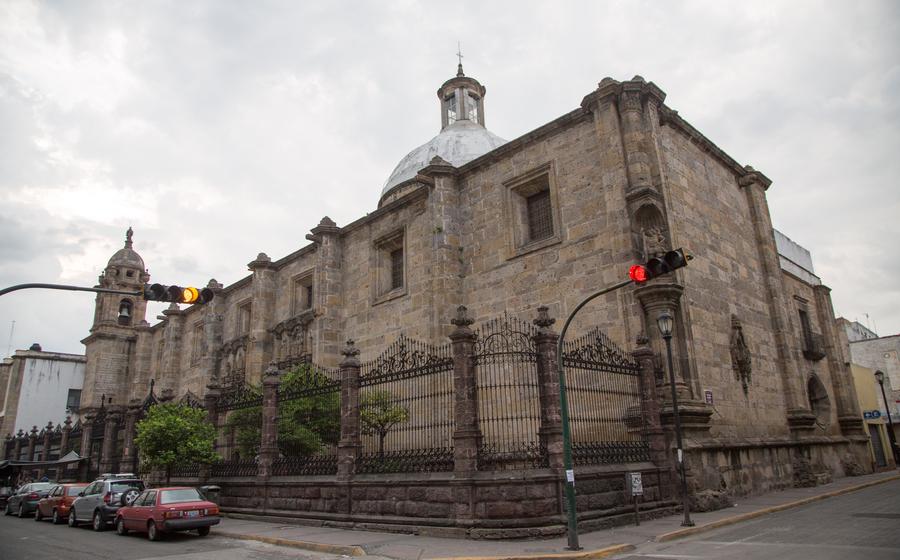
Templo de Jesús María
- Templo de Jesús María: A Baroque Masterpiece in Guadalajara
- Intricate Façade: A Symphony of Stone
- Majestic Altars: A Feast for the Eyes
- Captivating Murals: A Glimpse into the Past
- The Legend of the Virgin of Zapopan
- Guided Tours: Unveiling the Templo's Secrets
- Mass Schedule: A Sacred Experience
- Planning Your Visit: Essential Tips
- Capture the Essence: Photography Tips
- Nearby Attractions: Enrich Your Experience
- Respect and Etiquette: Guidelines for Visitors
- Insider Tip: Unveiling Hidden Details
Templo de Jesús María: A Baroque Masterpiece in Guadalajara
The Templo de. Built in the 18th century, this Baroque masterpiece is renowned for its intricate façade, awe-inspiring altars, and captivating murals. The church holds immense religious significance, serving as a pilgrimage site for devotees of the Virgin of Zapopan, whose miraculous image resides within its walls. Immerse yourself in the grandeur of this sacred space, where history, art, and devotion converge to create an unforgettable experience.
Intricate Façade: A Symphony of Stone
The Templo de Jesús María's façade is an awe-inspiring spectacle, a symphony of stone that captivates the eyes with its intricate carvings and sculptures. Crafted with meticulous precision, each element of the façade holds symbolic meanings and biblical references, reflecting the profound faith and artistry of its creators.
The intricately carved reliefs depict scenes from the life of Christ, the Virgin Mary, and various saints, narrating a visual story that invites contemplation and devotion. The indigenous artisans who contributed to the façade's creation infused it with their unique style, blending European Baroque influences with native artistic traditions.
One of the most striking features of the façade is its central niche, which houses a majestic sculpture of the Virgin Mary, the patroness of the church. The Virgin is depicted as the Immaculate Conception, surrounded by cherubs and angels, radiating an aura of grace and divinity.
The façade is not merely an architectural masterpiece but also a testament to the profound cultural and religious significance of the Templo de Jesús María. It stands as a symbol of faith, künstlerischer Ausdruck, and the harmonious fusion of European and indigenous influences that shaped Guadalajara's cultural heritage.
Majestic Altars: A Feast for the Eyes
The interior of the Templo de Jesús María is adorned with breathtaking altars and retablos, showcasing the intricate artistry and devotion of the Baroque period. The main altarpiece, dedicated to the Virgin Mary, is an awe-inspiring spectacle, towering over the nave with its grandiosity. Carved from wood and gilded in gold leaf, it features intricate carvings, sculptures, and paintings that depict scenes from the life of the Virgin and the saints.
The side altars, dedicated to various saints and religious figures, are equally impressive, each showcasing unique designs and artistic expressions. The attention to detail is remarkable, with gold leaf embellishments, delicate floral motifs, and cherubim adorning every corner. The altarpieces are a testament to the skill and dedication of the artisans who created them, and they serve as a focal point for worship and devotion within the church.
The retablos, or painted panels, that adorn the altars are another highlight of the Templo de Jesús María. These works of art depict biblical scenes and religious narratives, bringing the stories of faith and salvation to life. The vibrant colors and expressive brushstrokes captivate the viewer, inviting them to contemplate the deeper meanings and messages behind the images.
Captivating Murals: A Glimpse into the Past
The interior of the Templo de Jesús María is adorned with breathtaking murals that transport visitors back in time. These vibrant paintings cover the walls and ceiling, depicting biblical scenes, historical events, and religious iconography. The murals were created by renowned artists using a variety of techniques and styles.
One of the most striking murals is located above the main altar. It depicts the Assumption of the Virgin Mary, surrounded by a host of angels and saints. The mural is a masterpiece of Baroque art, with its rich colors, dynamic composition, and intricate details.
Another notable mural is found in the sacristy. It portrays the life of Saint Francis of Assisi, the founder of the Franciscan order. The mural is divided into several panels, each depicting a different scene from the saint's life. The panels are connected by a continuous narrative, allowing viewers to follow the saint's journey from his early years to his death.
The murals in the Templo de Jesús María are not only works of art but also valuable historical documents. They provide insights into the beliefs and values of the people who lived in Guadalajara during the colonial period. The murals also offer a glimpse into the artistic and cultural traditions of the time.
The Legend of the Virgin of Zapopan
Enveloped in an aura of devotion and reverence, the Templo de Jesús María is closely associated with the legend of the Virgin of Zapopan. According to local folklore, the miraculous image of the Virgin Mary was discovered by a humble indígena woman in the 16th century. Found hidden within the hollow trunk of a tree in the nearby town of Zapopan, the image was believed to possess divine powers. News of the miraculous discovery spread like wildfire, attracting pilgrims from far and wide who sought blessings and healing from the Virgin. Over time, the image became deeply revered, and the annual pilgrimage to the Templo de Jesús María, known as the Romería de Zapopan, was born. This grand religious festival, held each October, draws millions of faithful devotees who honor the Virgin and celebrate her protective presence. The procession, accompanied by music, dance, and colorful floats, is a mesmerizing spectacle that showcases the deep faith and devotion of the local people.
Guided Tours: Unveiling the Templo's Secrets
To fully appreciate the rich history, architecture, and legends associated with the Templo de Jesús María, consider booking a guided tour. These tours, led by knowledgeable guides, offer an immersive experience that brings the church's stories to life.
During the tour, you'll gain insights into the construction of the temple, the symbolism behind its intricate facade, and the significance of the various religious iconography throughout the interior. Learn about the life of Saint Ignatius of Loyola, the founder of the Jesuit order, and the role of the Jesuits in shaping the cultural and religious landscape of Guadalajara.
Guides will also share fascinating tales and legends surrounding the church, including the story of the miraculous image of the Virgin of Zapopan, which is deeply revered by the local community. They'll point out hidden details and architectural features that you might otherwise miss, such as the intricate carvings on the choir stalls or the secret passageway leading to the bell tower.
To book a guided tour, inquire at the church's main office or through authorized tour operators in Guadalajara. Tours are typically offered in Spanish, but English-speaking guides may be available upon request. Remember to check the tour schedule in advance, as availability may vary depending on the day and time.
Mass Schedule: A Sacred Experience
A visit to the Templo de Jesús María offers not only a glimpse into its architectural and artistic splendor but also an opportunity to connect with the local community through religious practice. The church holds regular masses, allowing visitors to immerse themselves in the sacred atmosphere and experience the devotion of the faithful. Attending mass is a chance to observe local customs and traditions, witness the vibrant expressions of faith, and share a moment of spiritual reflection with the community.
Masses are held at various times throughout the week, catering to the needs of worshippers with different schedules. Visitors are encouraged to check the church's website or inquire locally for the most up-to-date mass schedule. Respectful attire and behavior are expected, with silence and reverence maintained during religious services.
Participating in mass at the Templo de Jesús María is a unique and enriching experience, providing a deeper understanding of Guadalajara's religious heritage and the profound connection between the community and their faith.
Planning Your Visit: Essential Tips
To make the most of your visit to the Templo de Jesús María, careful planning and consideration are essential.
Best Time to Visit: The ideal time to visit Guadalajara and the Templo de Jesús María is during the dry season, from October to May, when the weather is pleasant and sunny. Avoid the rainy season (June to September), as heavy rainfall can hinder your exploration and photography. Additionally, try to visit during weekdays to avoid the larger crowds that typically gather on weekends.
Recommended Attire: When visiting the Templo de Jesús María, it is important to dress respectfully, as it is an active place of worship. Opt for modest clothing that covers your shoulders and knees. Avoid wearing shorts, tank tops, or revealing attire.
Accessibility Features: The Templo de Jesús María is accessible to visitors with disabilities. There are ramps and elevators available to facilitate entry and movement within the church. If you require any assistance, do not hesitate to ask a member of the church staff or a tour guide.
Capture the Essence: Photography Tips
The Templo de Jesús María is a photographer's paradise, with its intricate details and stunning architecture. To capture the essence of this magnificent structure, here are some photography tips:
-
Utilize Natural Light: Embrace the beautiful natural light that floods the church during the day. The soft, diffused light can create stunning shots with rich colors and textures.
-
Experiment with Angles: Play with different angles to capture unique perspectives. Shoot from below to accentuate the grandeur of the façade or from above to showcase the intricate ceiling murals.
-
Focus on Details: Don't forget to zoom in and focus on the intricate carvings, sculptures, and decorative elements that adorn the church. These details add depth and character to your photographs.
-
Use a Tripod: To avoid camera shake and capture sharp images, consider using a tripod. This is especially important when shooting in low-light conditions or when using a telephoto lens.
-
Be Patient: Photography is all about patience. Take your time to explore the church and find the perfect composition. Wait for the right moment, such as when the sunlight streams through the stained-glass windows, to create a truly magical shot.
Nearby Attractions: Enrich Your Experience
Beyond the Templo de Jesús María's captivating allure, Guadalajara offers a treasure trove of nearby attractions that will further enrich your cultural immersion. Just steps away, you'll find the Plaza de la Liberación, a vibrant square adorned with lush gardens, where you can relax and soak in the city's atmosphere. History buffs can explore the Palacio de Gobierno, which houses impressive murals by renowned Mexican artist José Clemente Orozco, providing a glimpse into the country's rich past.
For those seeking a culinary adventure, the surrounding streets are lined with an array of restaurants and cafes catering to every palate. Indulge in traditional Mexican cuisine at one of the many local eateries, or savor international flavors at one of the trendy establishments. Don't miss the Mercado Libertad, a bustling market where you can haggle for souvenirs, sample local delicacies, and witness the vibrant daily life of the city's inhabitants.
Guadalajara is renowned for its vibrant art scene, and the surrounding area offers ample opportunities to immerse yourself in its creative spirit. Galleries showcasing contemporary works by local and international artists are scattered throughout the neighborhood, inviting you to discover emerging talents and admire unique perspectives.
Respect and Etiquette: Guidelines for Visitors
As visitors, it is important to show respect for the Templo de Jesús María and the local community. Proper behavior and dress code are essential. When entering the church, maintain silence and reverence, especially during religious services. Photography is permitted, but always ask for permission before taking pictures of people or religious objects. Respecting these guidelines ensures a harmonious and enjoyable experience for all visitors.
Insider Tip: Unveiling Hidden Details
Beyond the evident magnificence of the Templo de Jesús María, there are hidden details and secrets waiting to be discovered by observant visitors. Keen eyes may spot a discreetly carved pelican perched atop one of the church's exterior cornices, a symbol of devotion and purity often associated with the Virgin Mary. Another secret lies in the form of a concealed passageway leading to the bell tower, accessible through a nondescript door near the sacristy. For those with a taste for the macabre, the church also houses underground crypts, where the remains of prominent figures from Guadalajara's past are interred. These hidden gems add an extra layer of intrigue and fascination to the Templo de Jesús María, inviting visitors to delve deeper into its rich history and symbolism.
